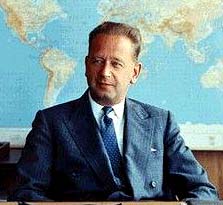|
 |
||||||||||||||||||||||||||||||||||||||||||||||||||||||||||||
|
Course home
page
Assignment What contributions to world peace and the organization of the United Nations did Dag Hammarskjold make as its second Secretary-General? Background Dag Hjalmar Agne Carl Hammarskjold was born on July 29, 1905, in a small town in Sweden to a family that had aristocratic origins dating to the seventeenth century. His father served as prime minister during World War I. While attending Uppsala University between 1926 and 1930, Hammarskjold earned degrees in political economics and law, and after receiving a doctorate in political economics at Stockholm University, he took a position in the National Bank of Sweden in 1936, eventually becoming Under-Secretary of Finance of the country. The Swedish Academy asked him to take the seat previously held by his father. After World War II, Hammarskjold joined the Foreign Affairs Office as an Under-Secretary, later becoming its secretary-general with a primary focus on international economic development. Through his efforts with the Organization for European Economic Cooperation (OEEC), he became widely known in international diplomatic circles. He succeeded Norway's Trygve Lie and became the second Secretary-General of the United Nations in 1953. His reelection in 1957 was unanimous. Chosen to be UN Secretary-General because of his calm demeanor, diplomatic skills and knowledge of political economics, Hammarskjold had a strong belief in the necessity of an organization like the United Nations. His upbringing had left him with a commitment to public service and social justice, as well as a commitment to equality and his belief in the sanctity of the law. He recognized the need for fair treatment of small states in the world organization. Widely respected throughout the world community, his efforts brought great respect and moral leadership to the fledgling organization. Hammarskjold recognized the need for the independence of the Secretary-General and worked diligently to insure that the UN was not perceived as being in one camp or another during disputes among various member states. He formed the UN Force that went to the Suez Canal in 1956 to aid in the resolution of that international dispute and to oversee the reopening of the Canal. He also formed another UN Force to aid in the Congo crisis which developed after the Congo declared its independence from Belgium in 1960. Civil war erupted in the Congo because of the attempt by the Belgians and other economic interests to retain control of the rich mining areas through the use of mercenary troops. Hammarskjold sought to position UN peacekeepers between the warring factions. While traveling in Africa in an attempt to aid in the resolution of Congo Crisis, the Secretary-General's plane crashed and burned just before midnight on September 17, 1961 while attempting to land in what was then known as Rhodesia. It is still not known whether the plane crashed as the result of an accident or by deliberate action of a malevolent hand. Recent statements by investigators of the Truth Commission in South Africa have alleged involvement by South African forces in the plane crash. There have also been allegations linking the CIA and Britain's MI6 to the crash. The governments involved have denied complicity and the crash remains a continuing diplomatic mystery. Dag Hammarskjold received the Nobel Peace Prize posthumously in 1961. His personal diary was published after his death as a book entitled Markings. The United Nations renamed its library as the Dag Hammarskjold Library and designated the Dag Hammarskjold Medal to be awarded to UN Forces who die while performing their peace missions. Timeline
WWW sites Official United Nations biography of Secretary-General Dag Hammarskjold. The United Nations Library, named for Dag Hammarskjold, is used by the UN Secretariat and Member Nation delegations. The Dag Hammarskjold Medal is awarded to those who are injured or die while serving in UN Forces. The text of the posthumous presentation of Hammarskjold's Nobel Peace Prize (and biography).  History of the UN Milestones Major Achievements
Recommended Books Markings (1961), by Dag Hammarskjold (NVCC: D839.7.H3 A313) (GMU: D839.7.H3 A3)
Related Events |
|||||||||||||||||||||||||||||||||||||||||||||||||||||||||||||